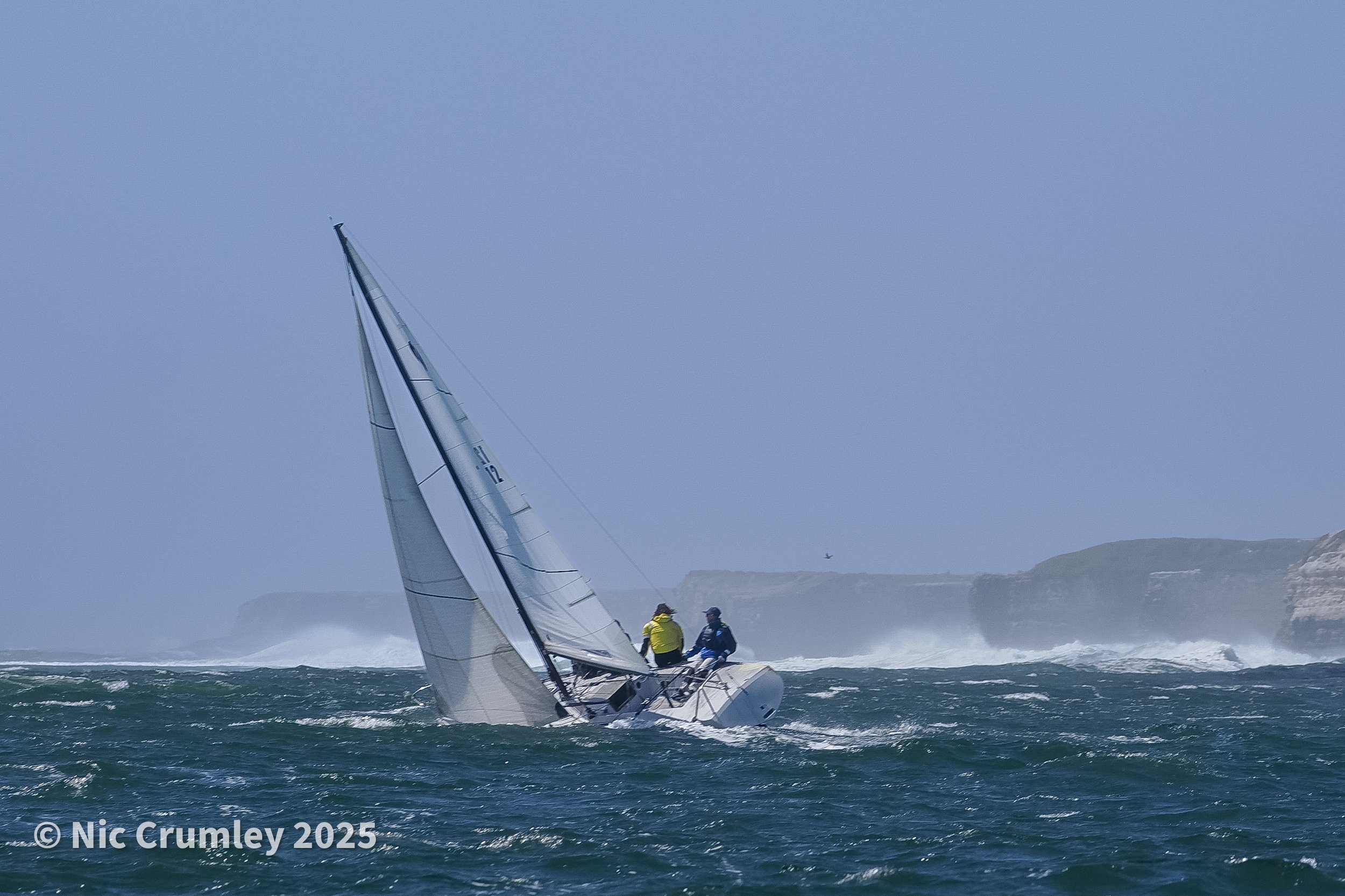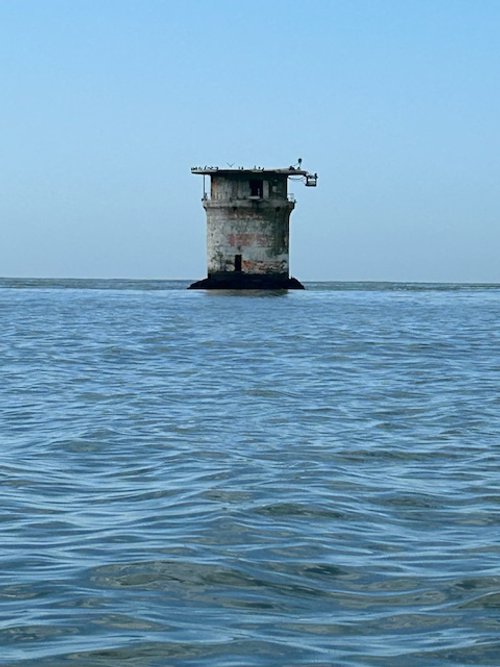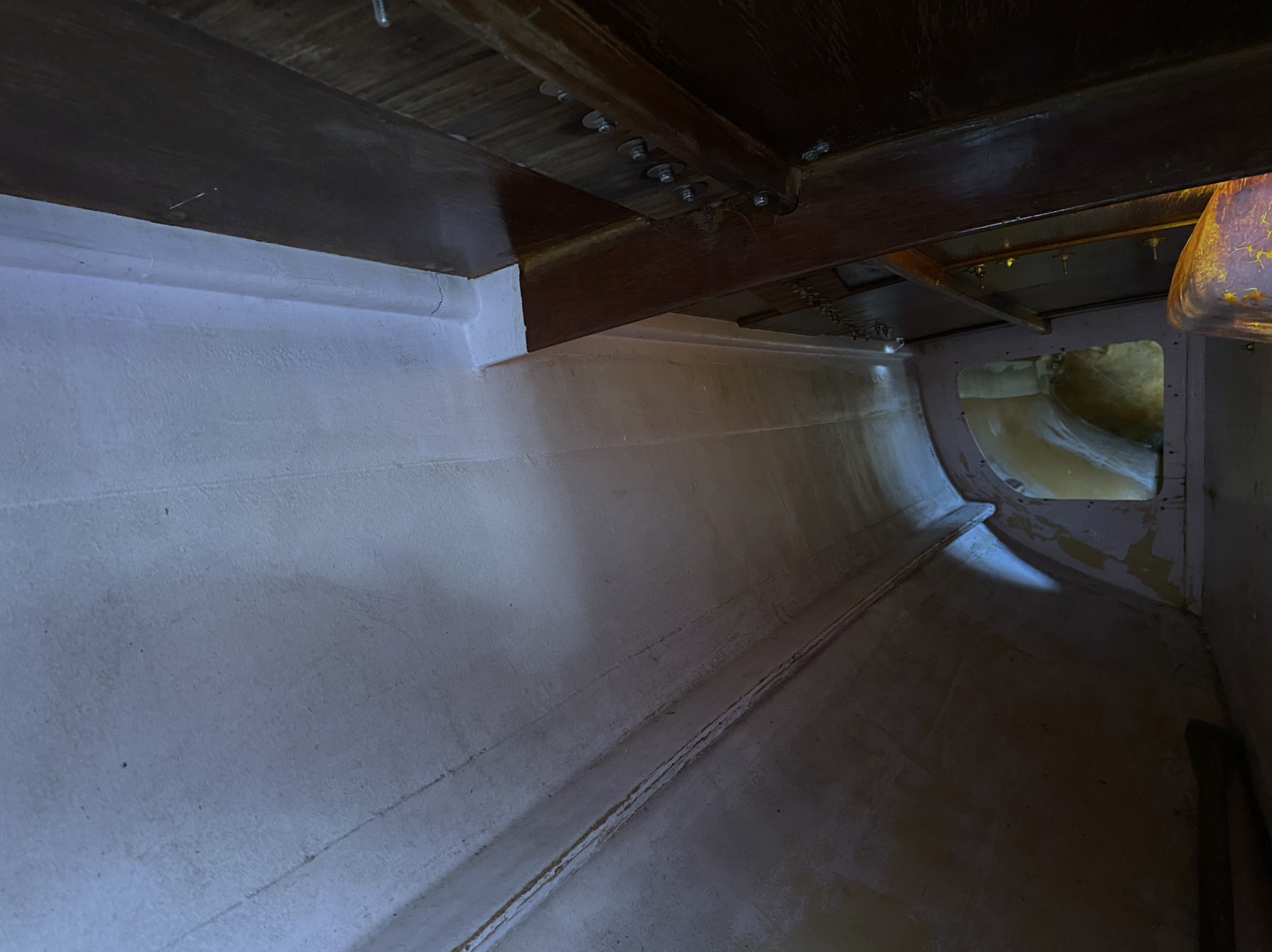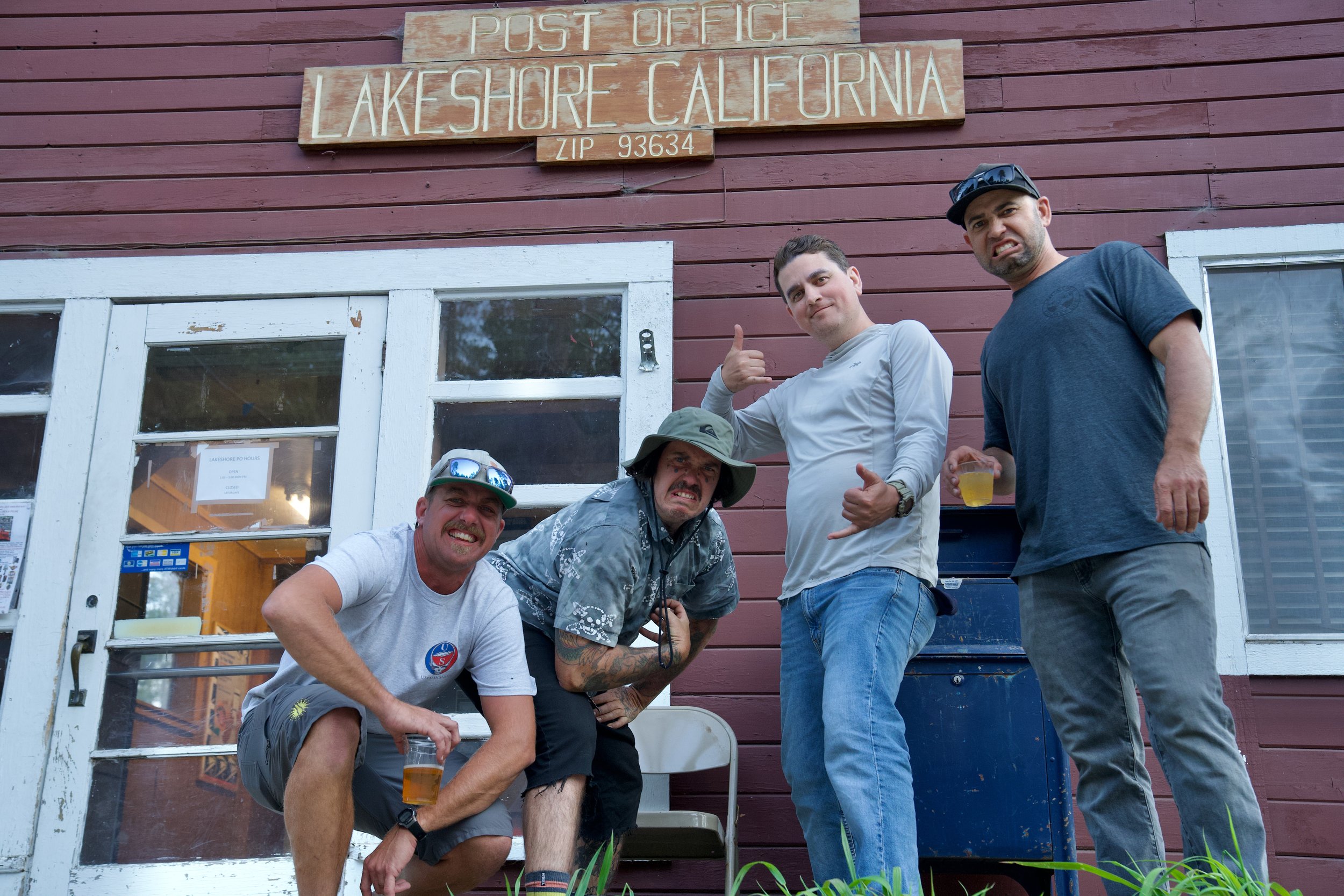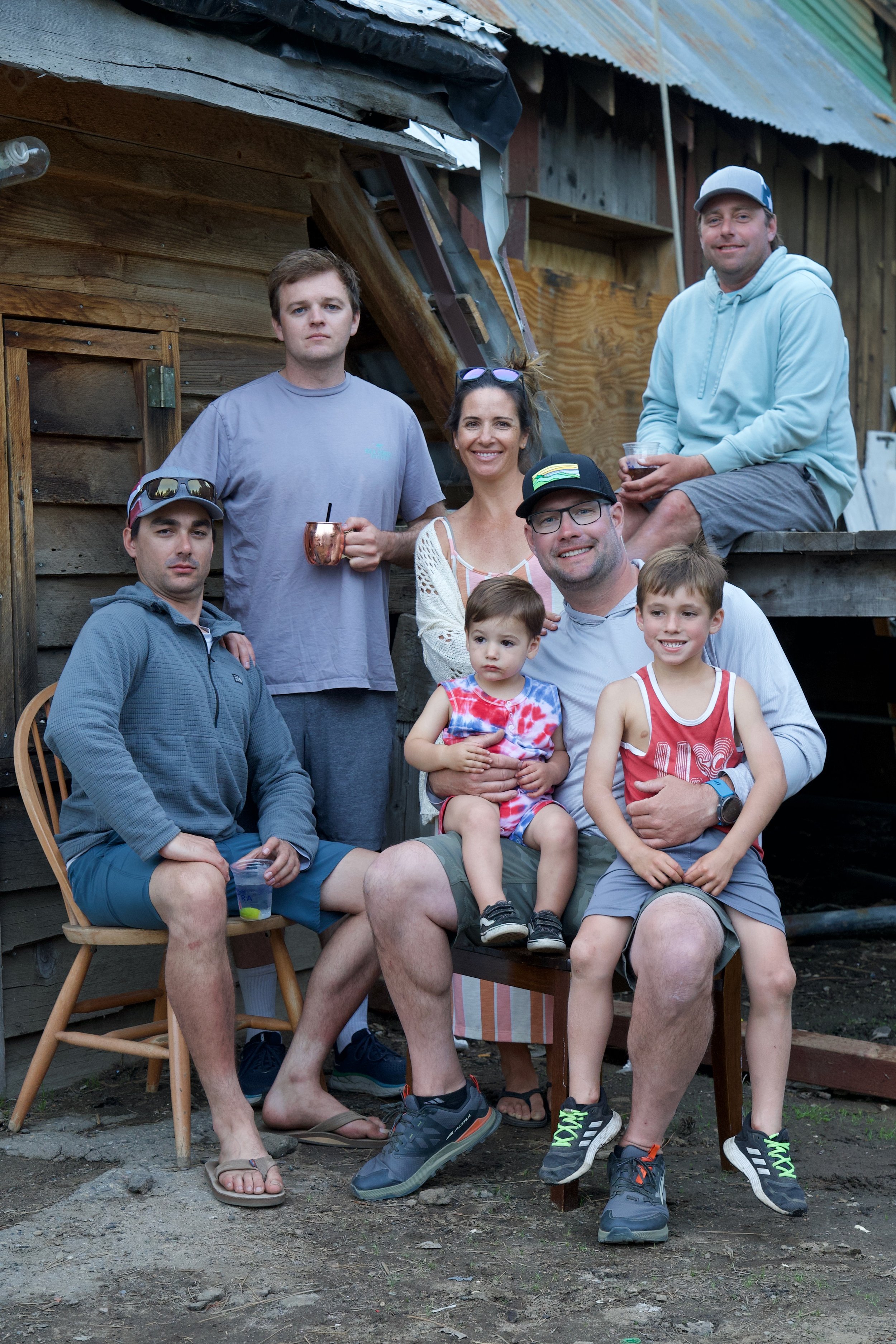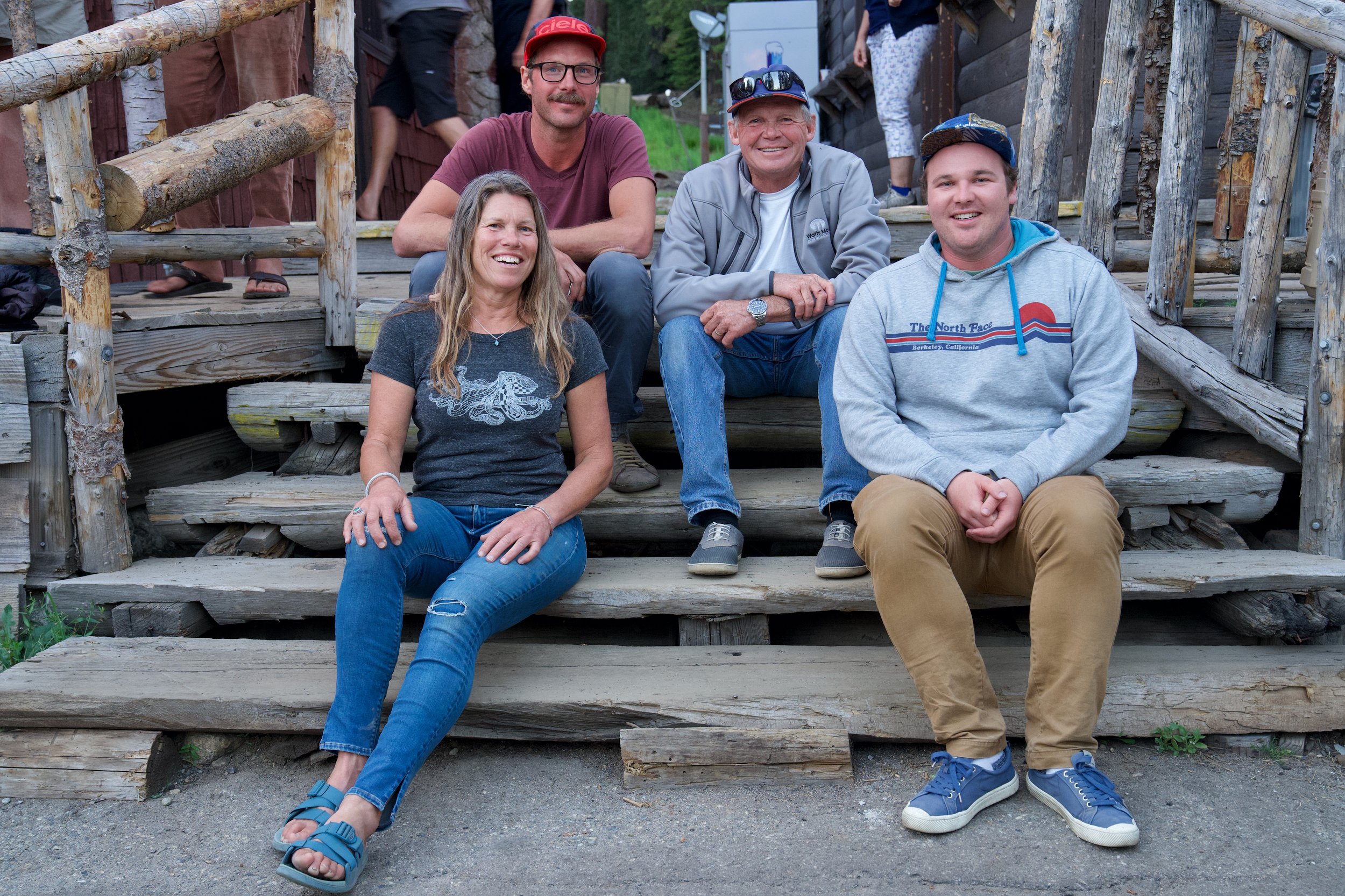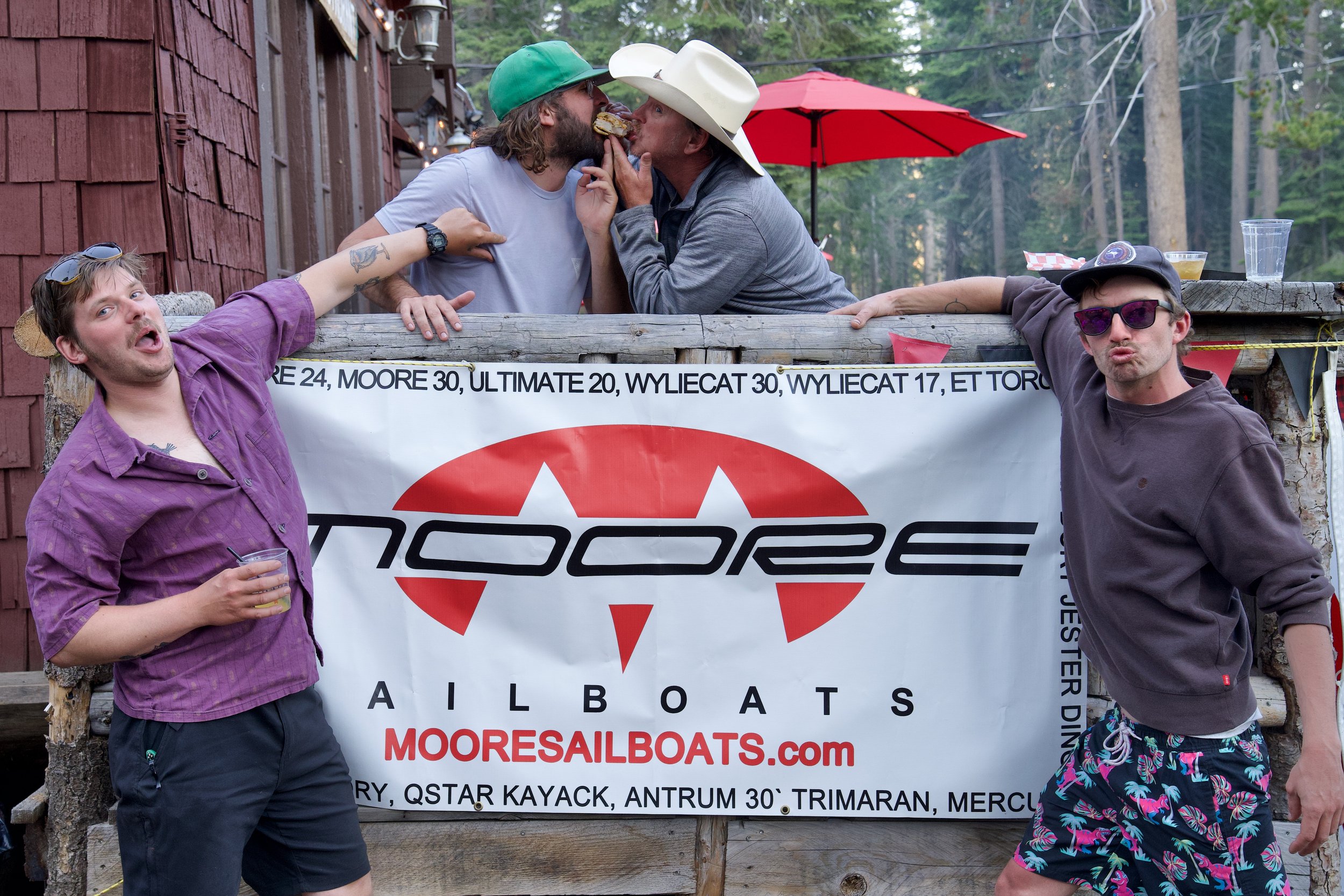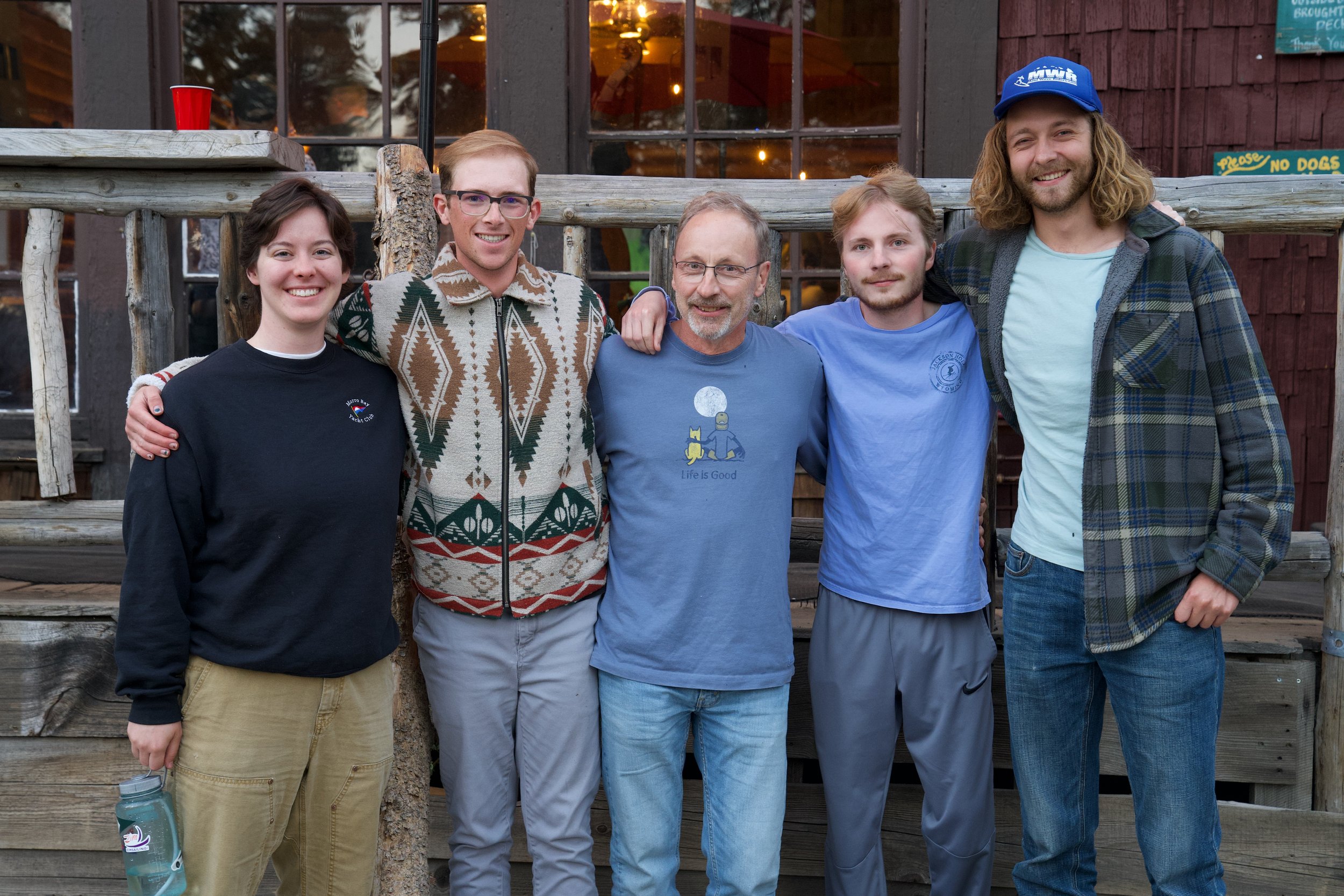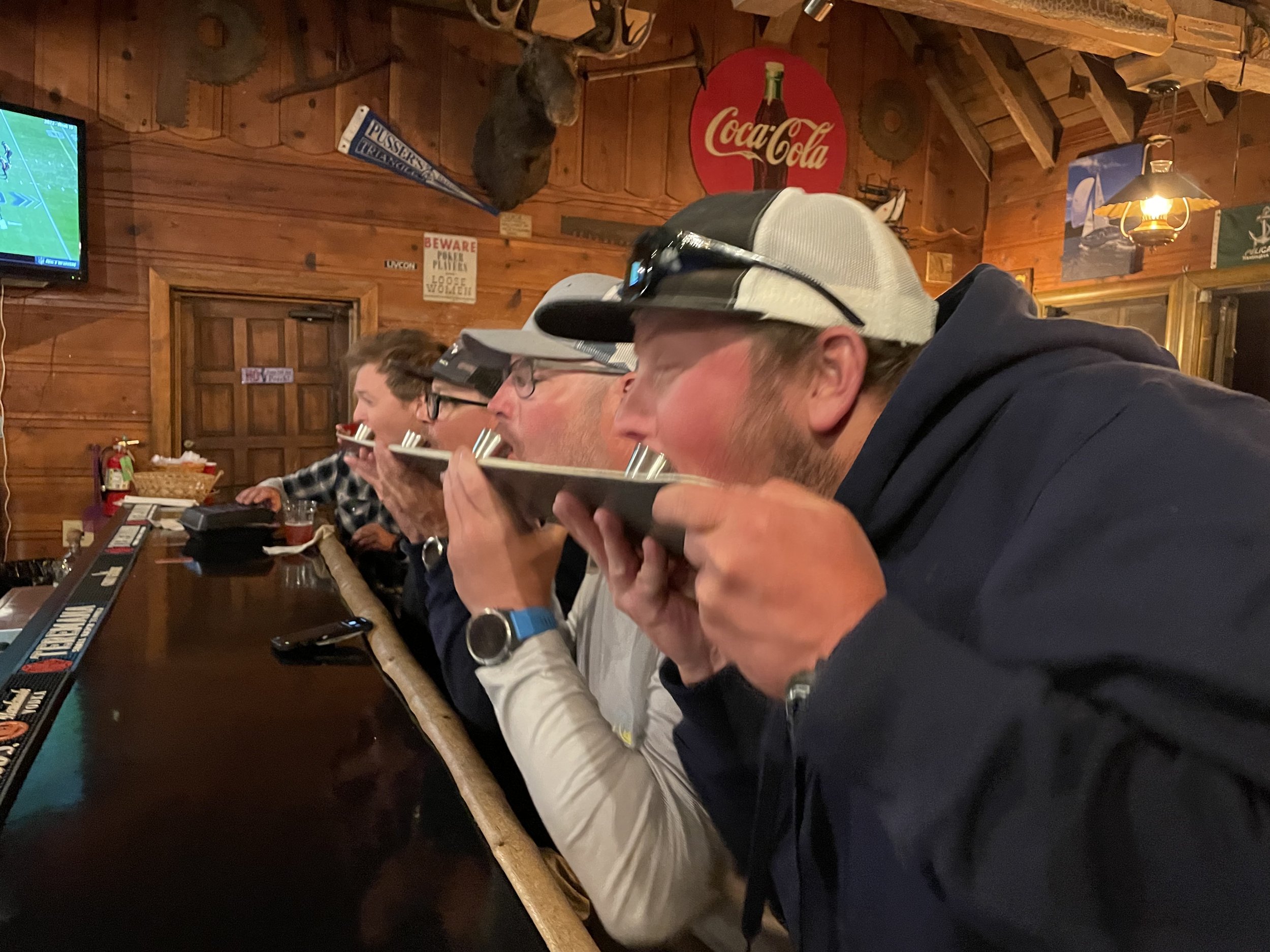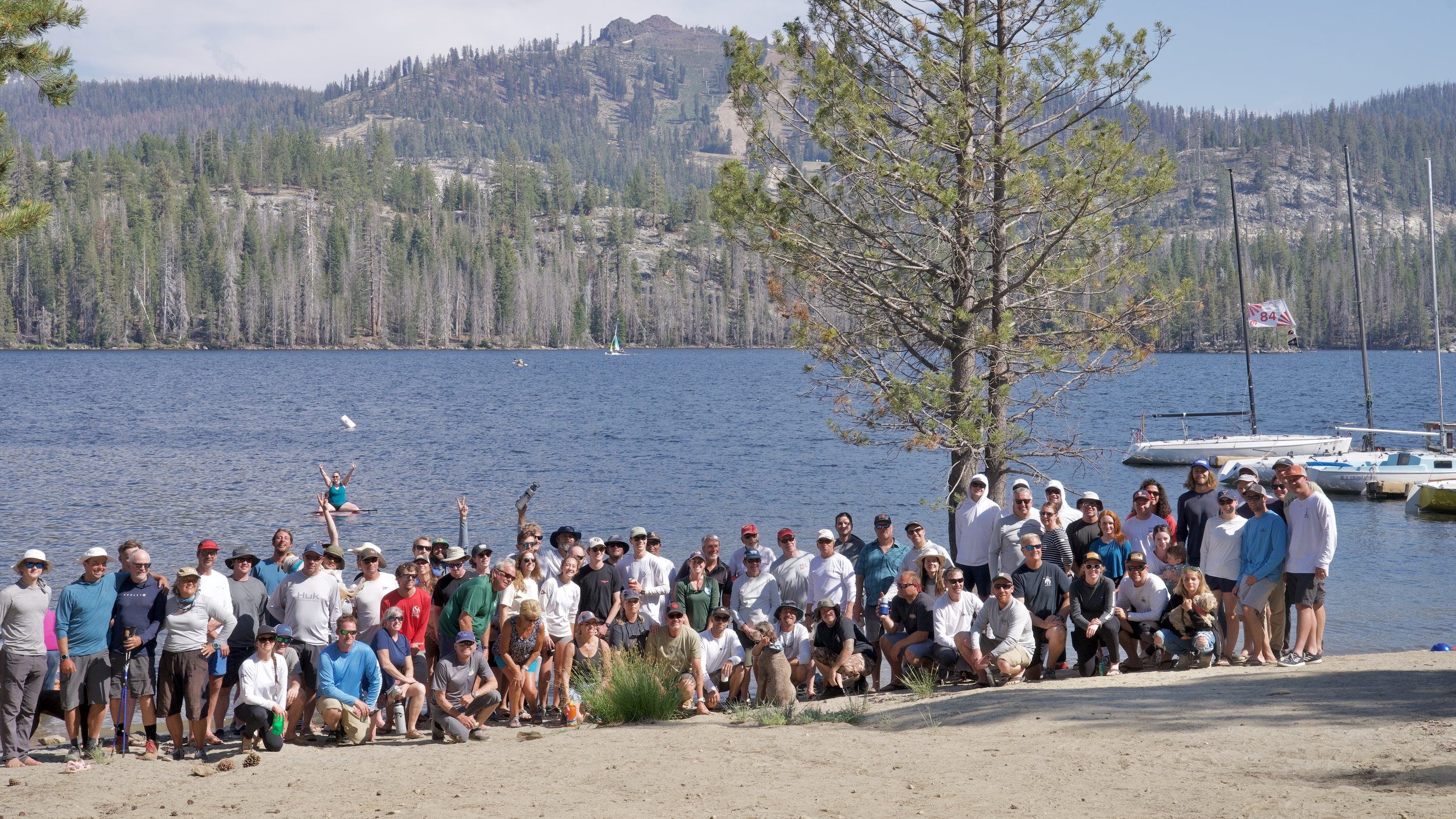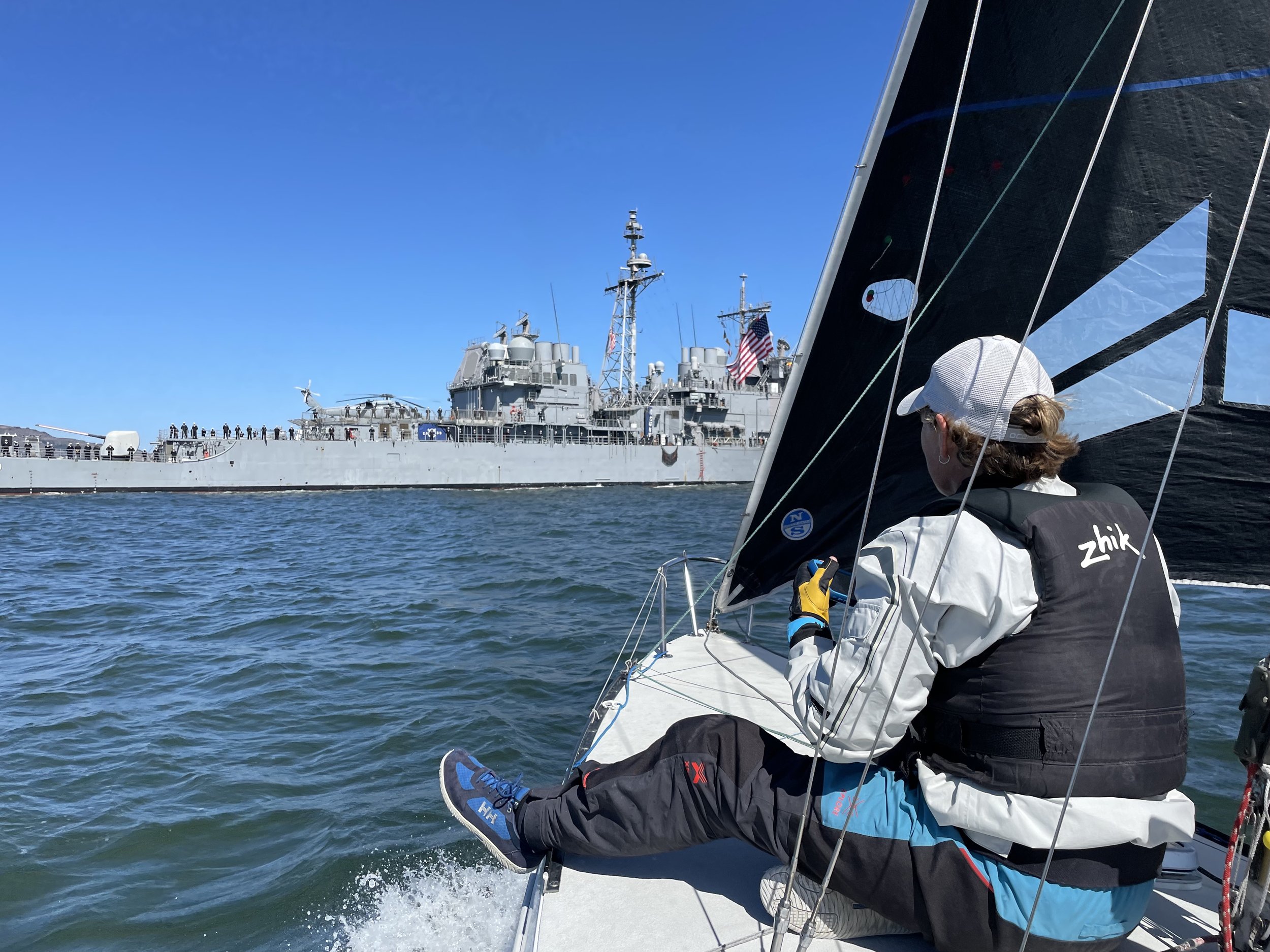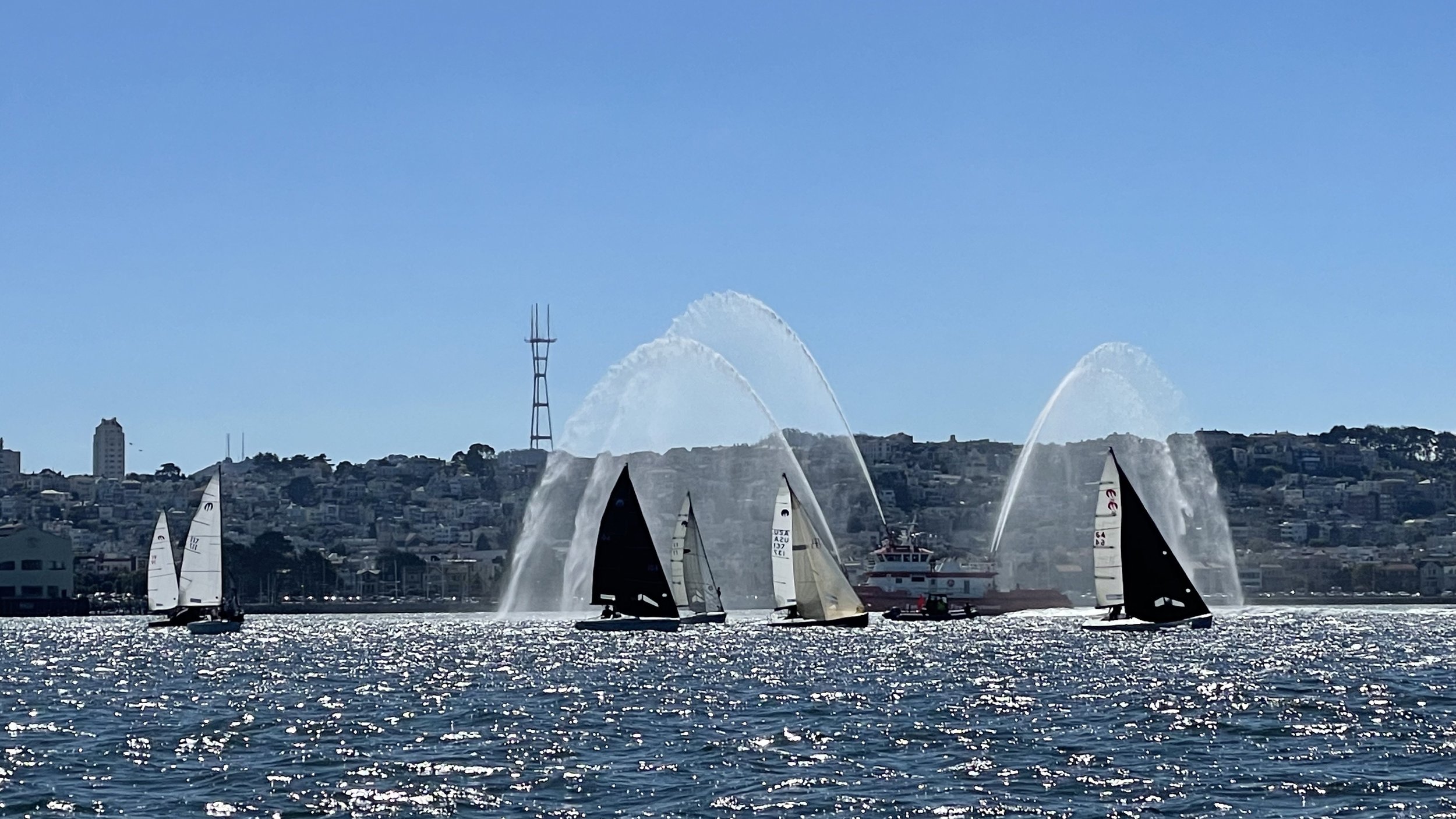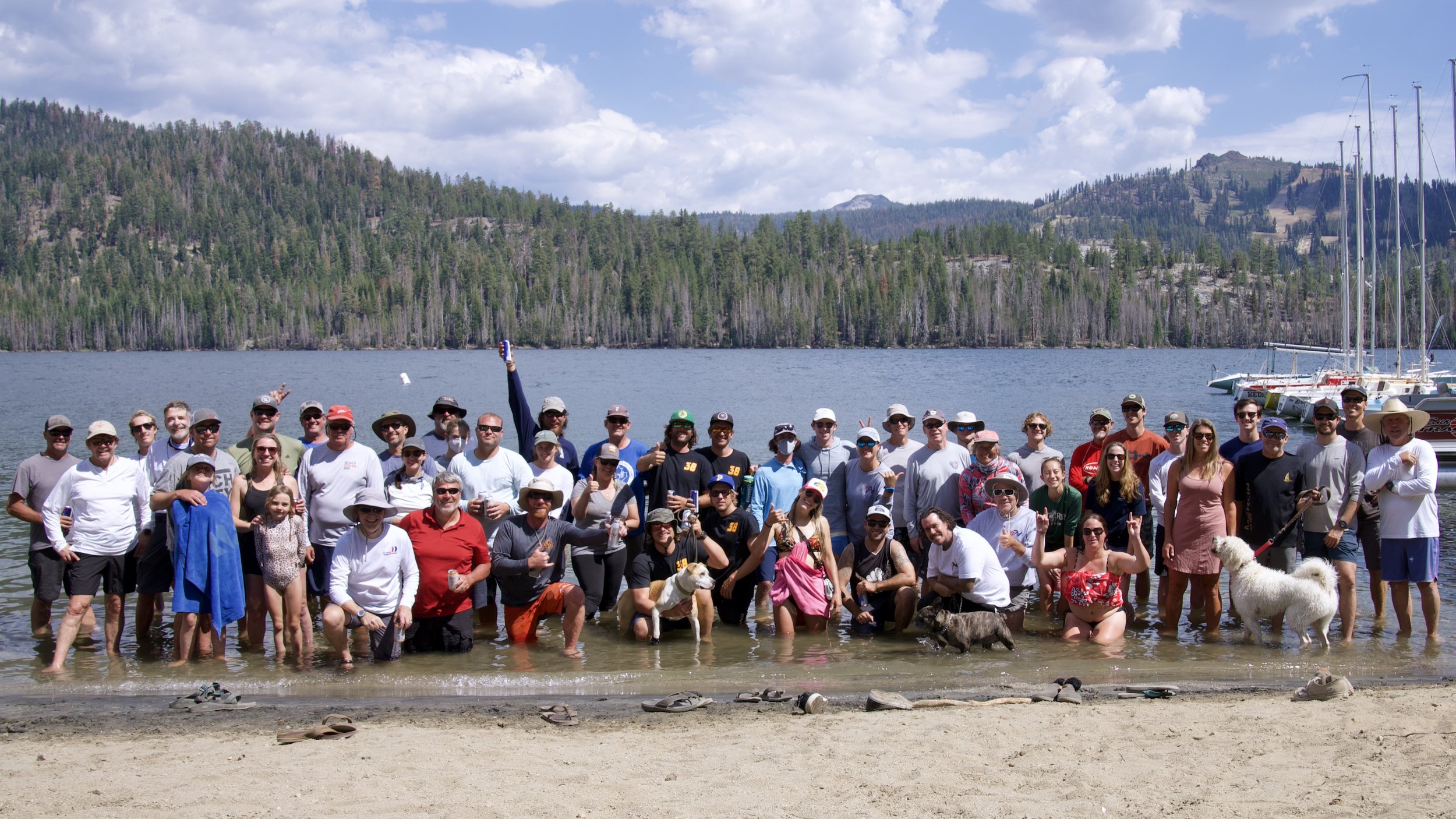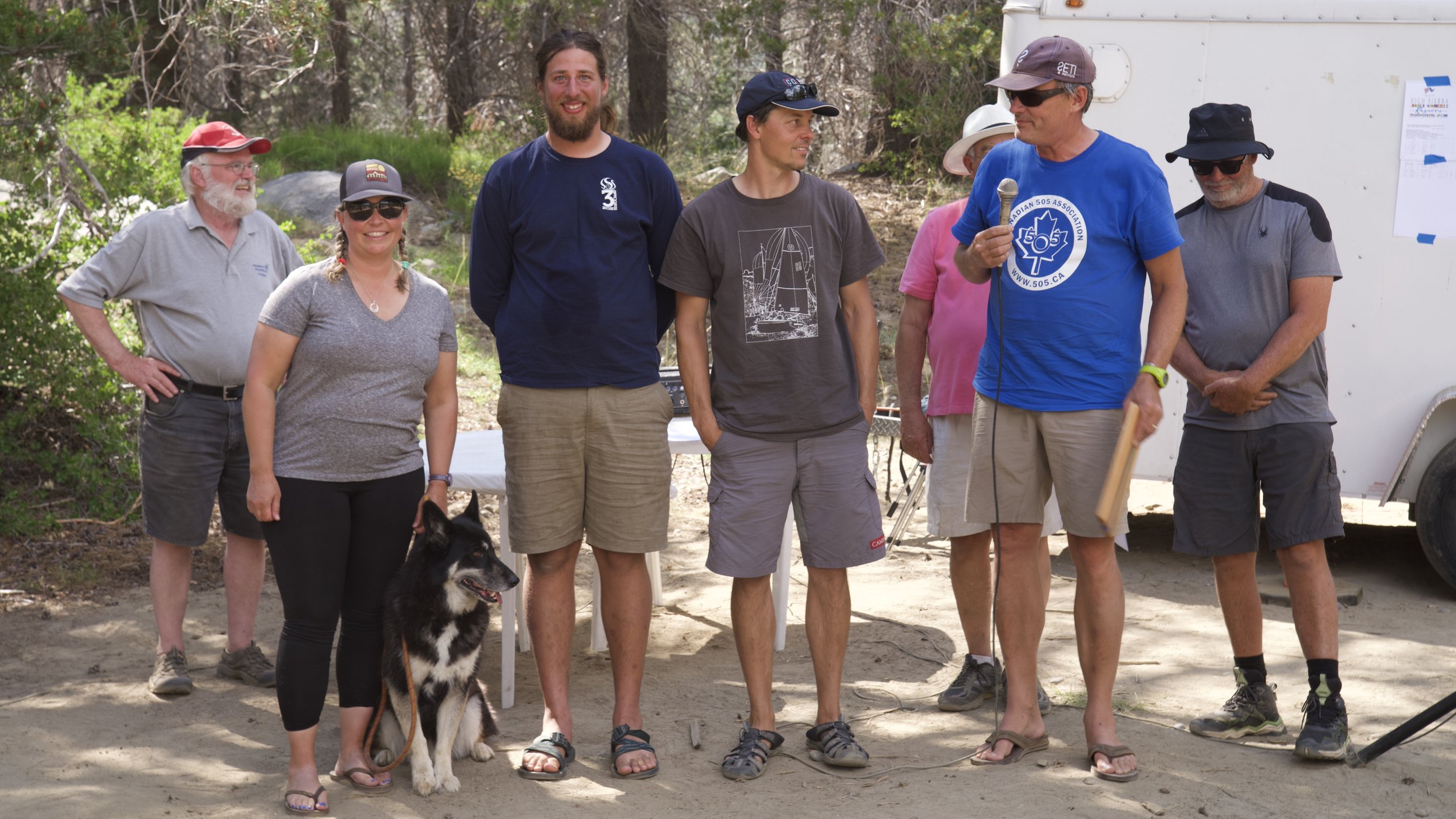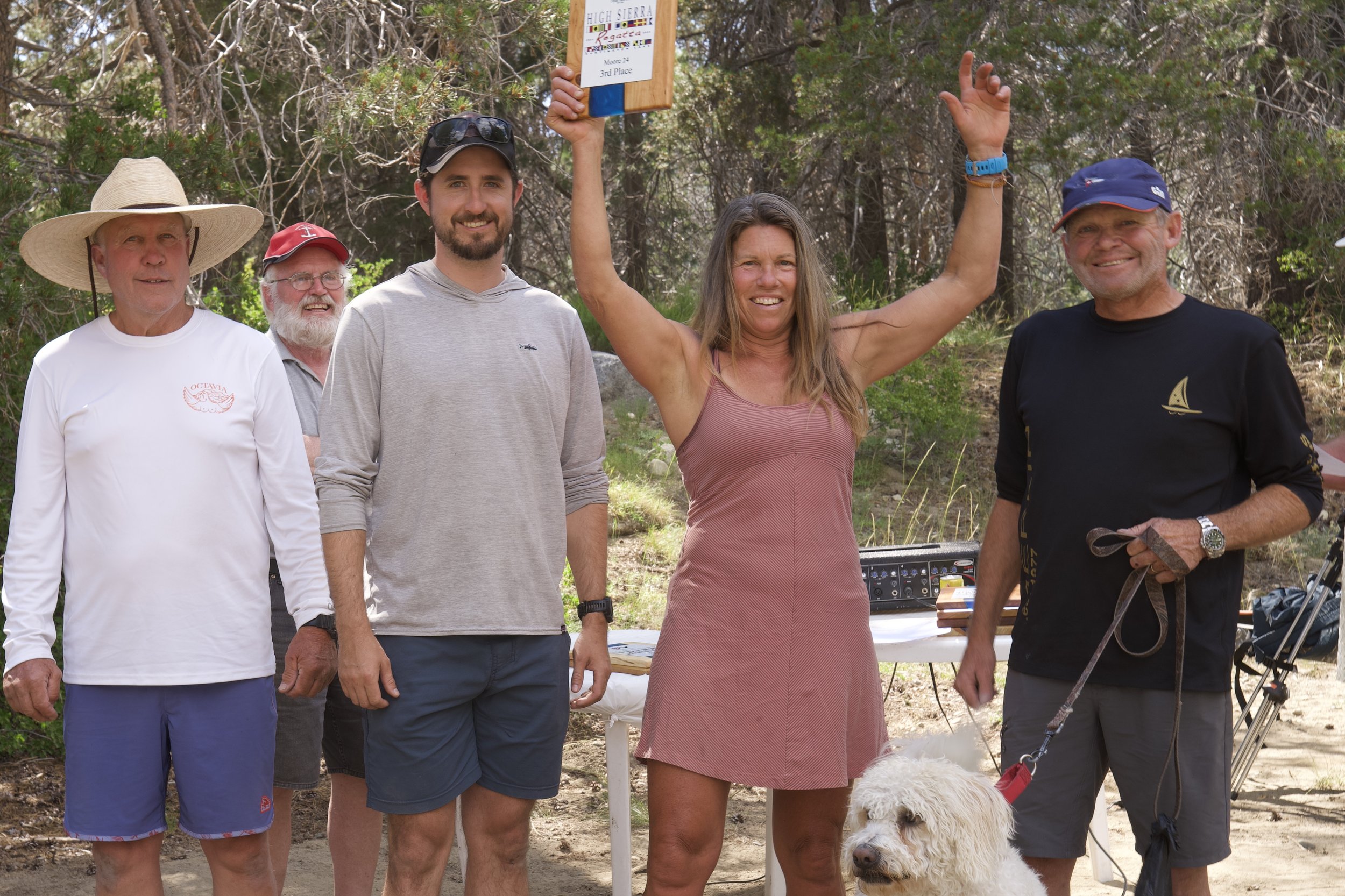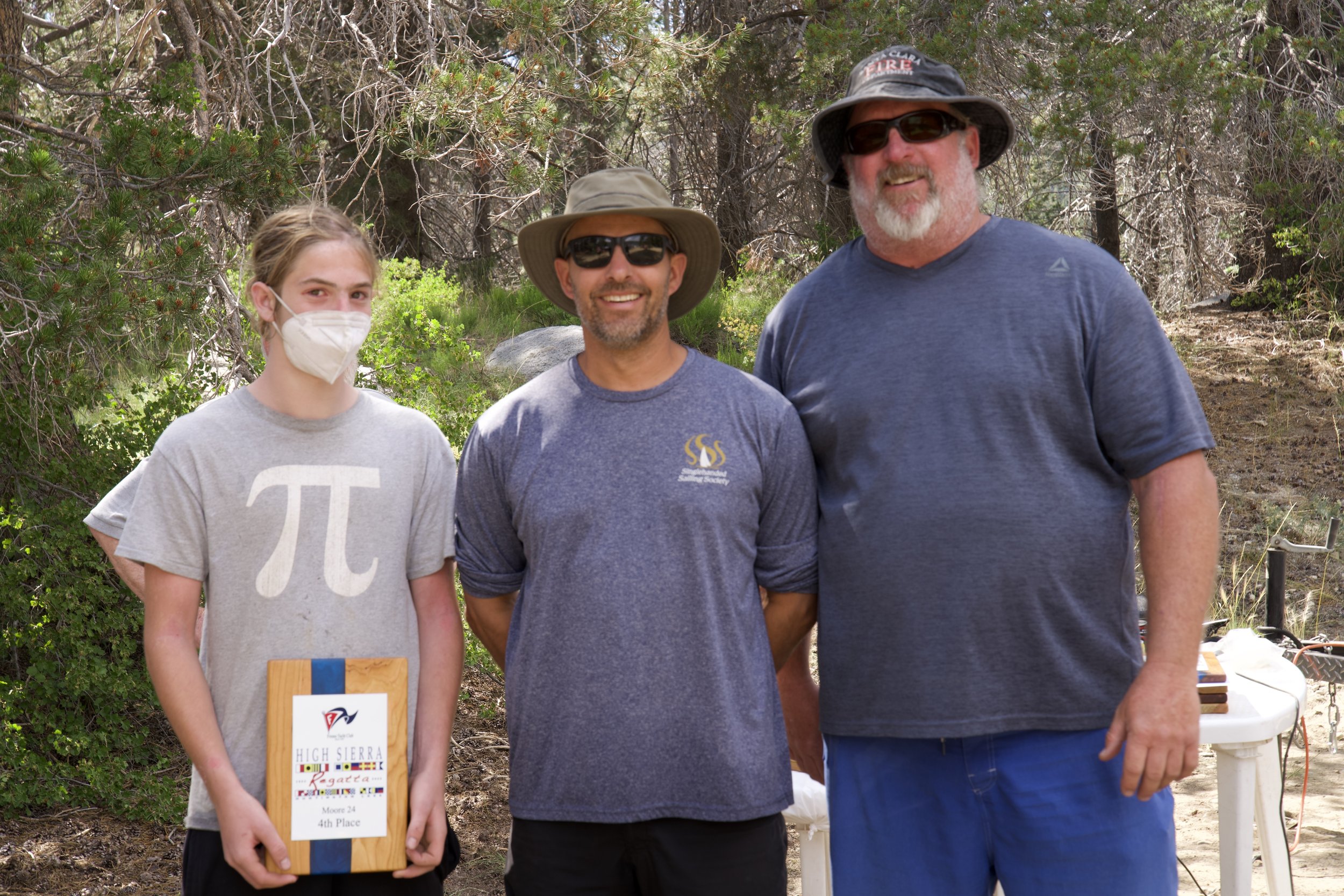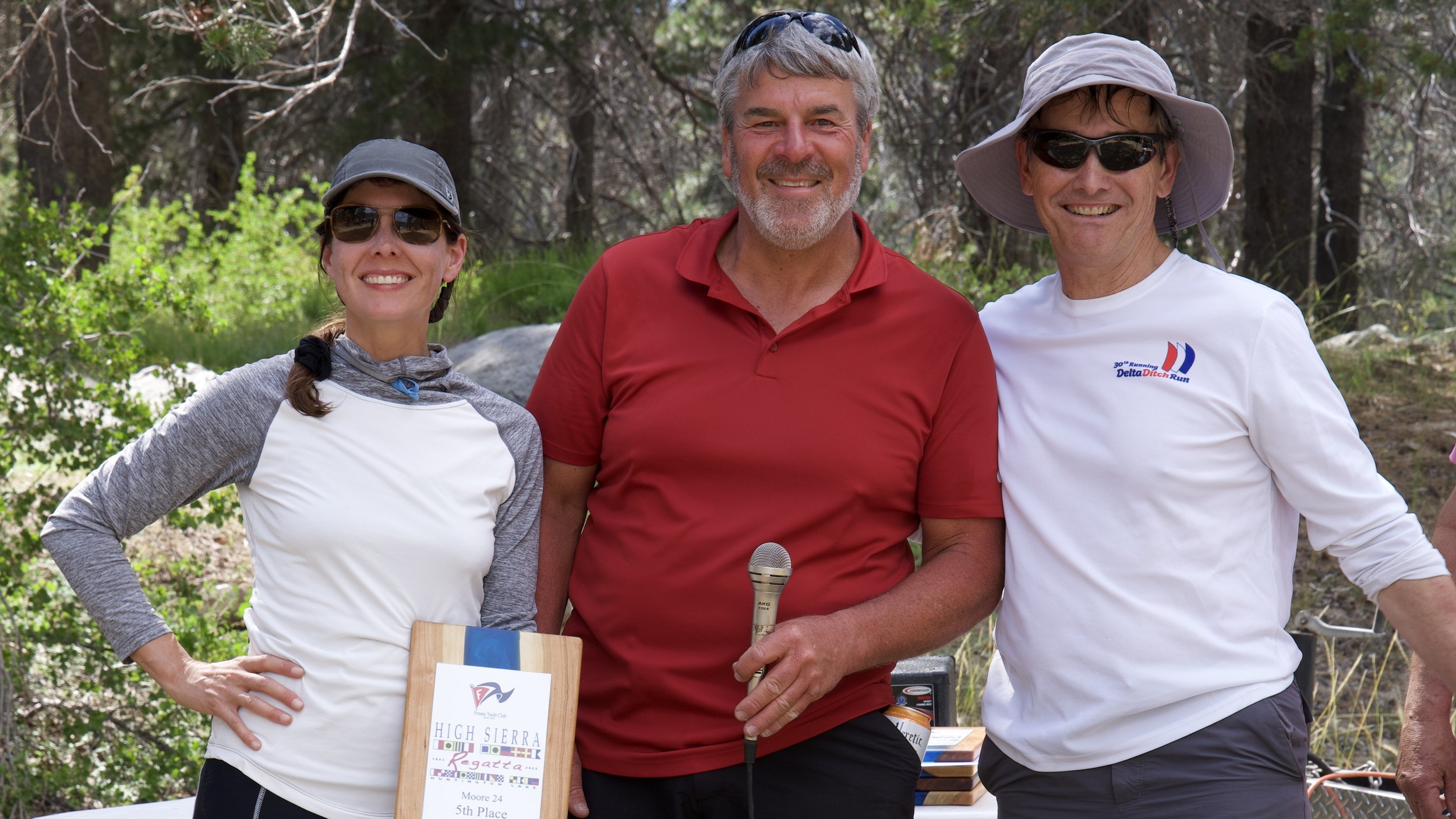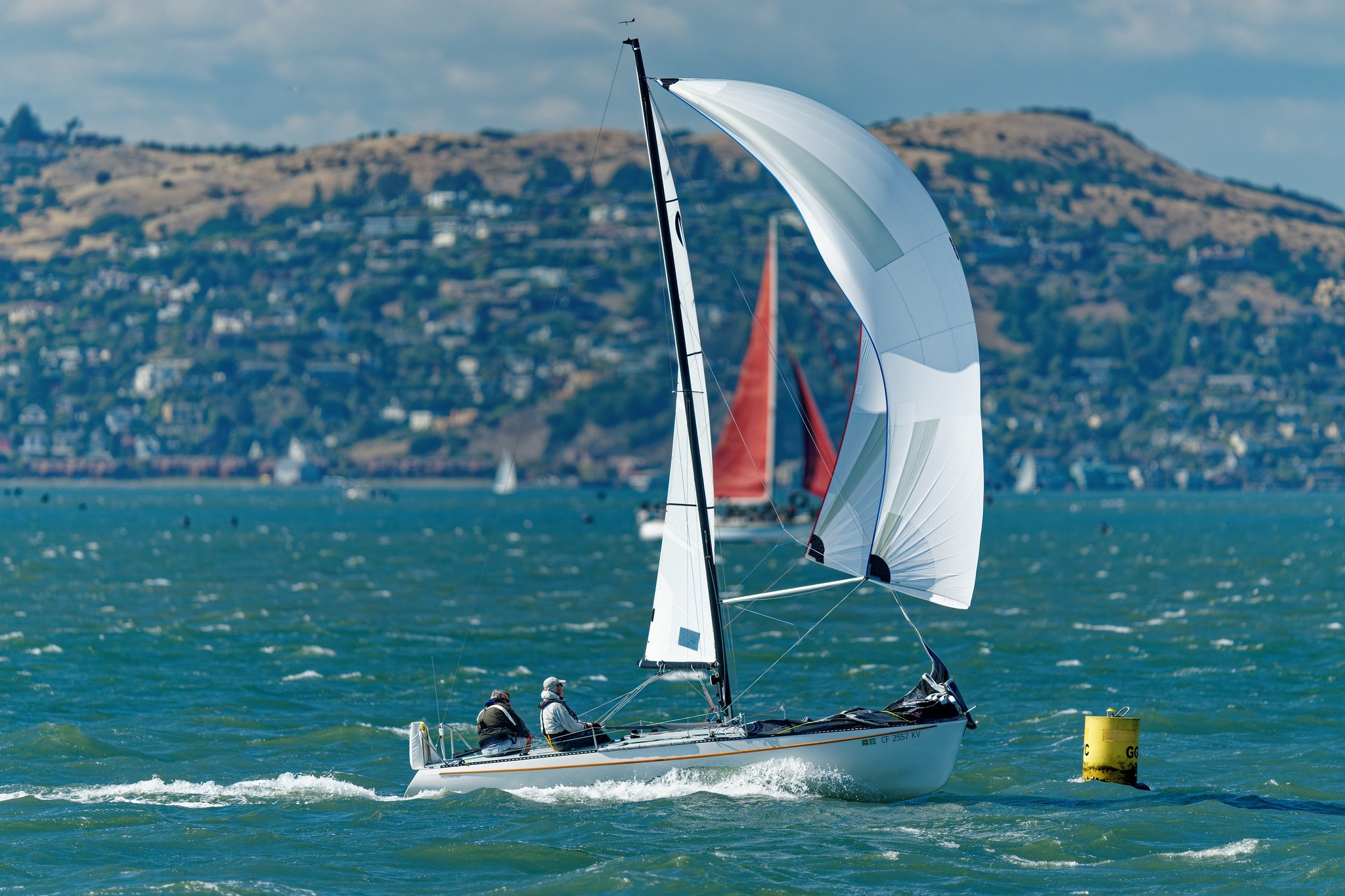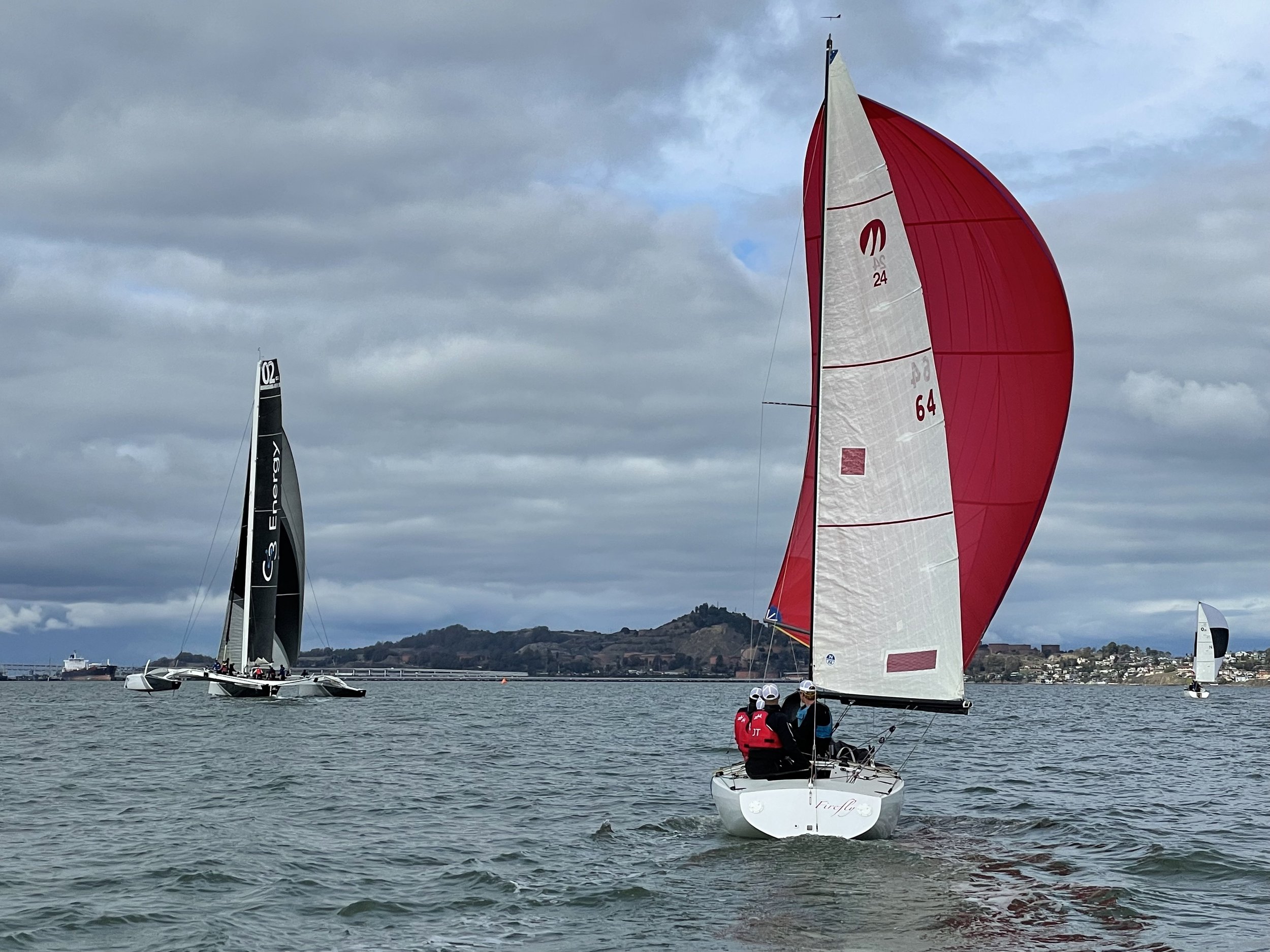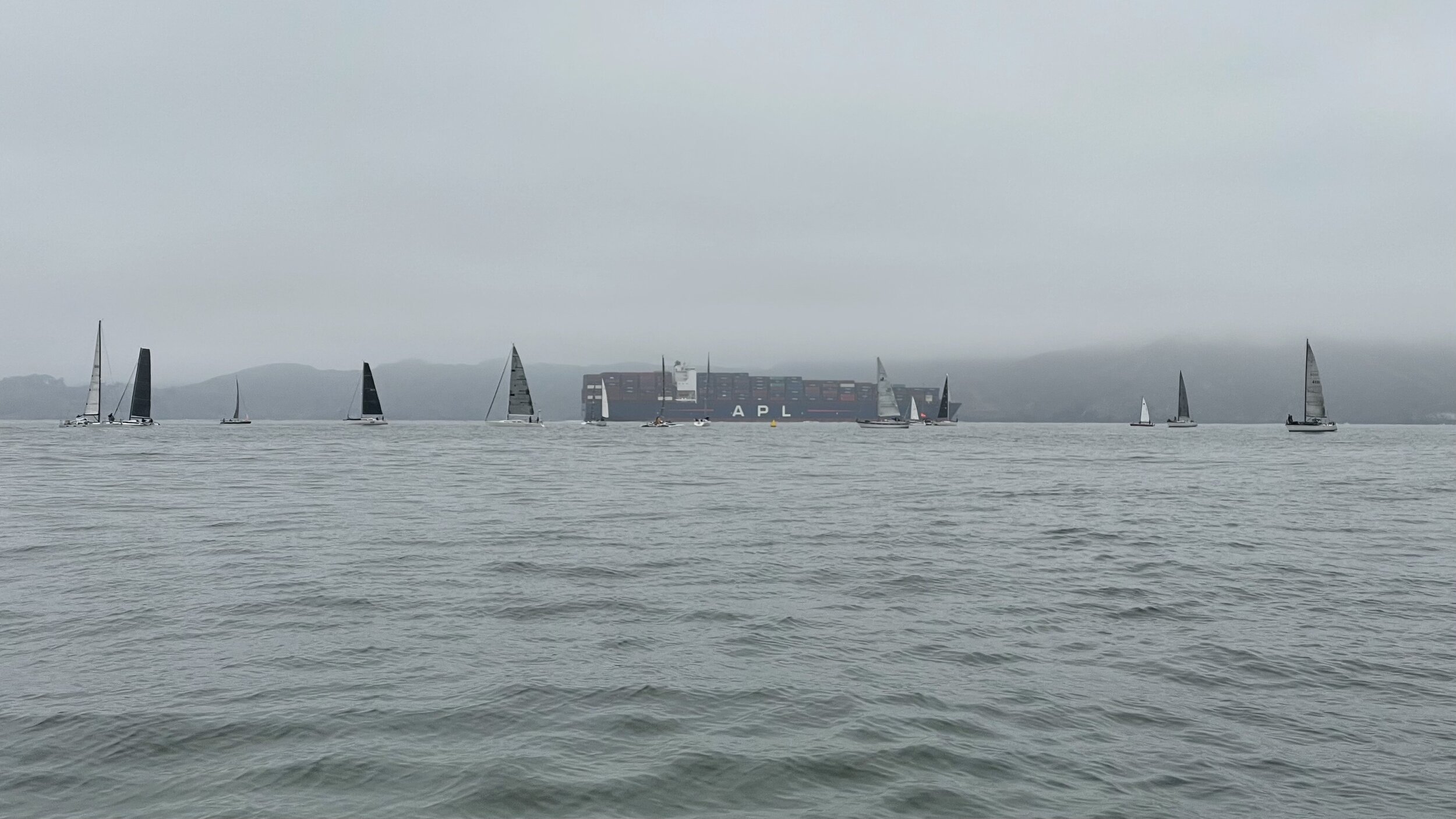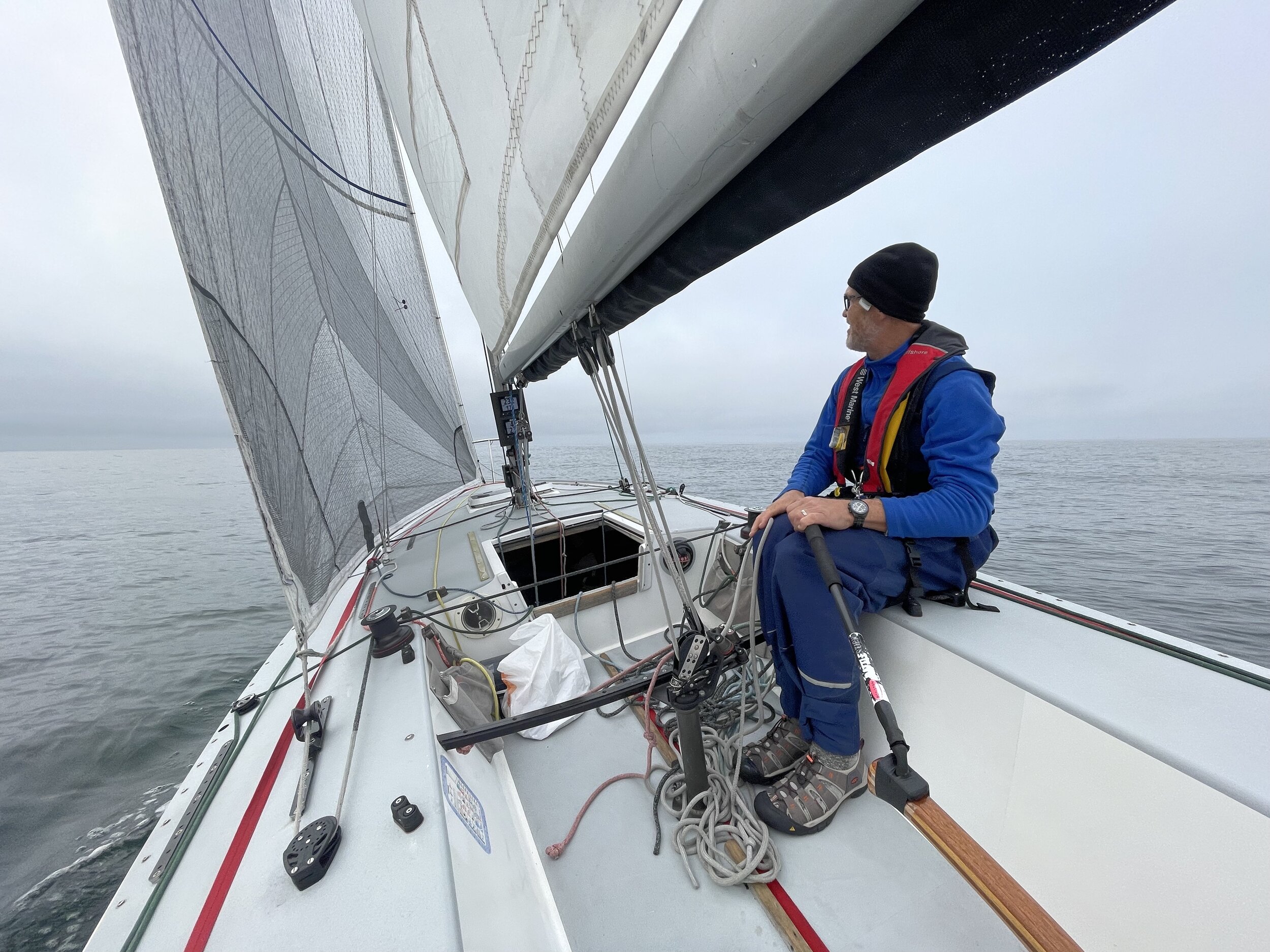Summertime’s performance had attracted quite a bit of attention during her summer of sea trials. Several people were interested in purchasing a hull as a kit once they became available. Two of these were Dr. Robert (Bob) Wade and his son Rob. They were campaigning their family’s Cal 2-24 “Tootsie Roll” in MBYRA (Monterey Bay Yacht Racing Assoc.) and wanted a faster boat. By 1974, the first Moore 24 “kits” were appearing. I think #5, “Relma” was the first. These were all narrow cockpit boats that were rigged with recycled Proctor Tempest or Soling masts. One, #3, was “Quicksilver” owned by Andy Anderson. Andy and I were friends, and Ruth and I often sailed with him on the boat. Rob and Jack Halterman were often aboard as well. Rob and Jack had just won the National Intercollegiate Sloop Championship, sailing for UCSC in Shields sloops on the East Coast. They were very competitive.
By then, Rob had convinced his father that if you wanted to win races in a 24 foot boat the Moore 24, as it was starting to be called, was the way to go. But, what to use for a rig? At that point the Moores were not producing rigged boats. There was no class, so anything that would fit was eligible. Although Summertime sailed well with her masthead rig, the kit boats’ Proctor rigs were too flexible to support adequate rig tension. More importantly, Rob had a real affinity for the 15/16th rig on the Cal 2-24. It didn’t sacrifice too much spinnaker area, didn’t require jumpers or runners to get adequate headstay tension, yet still allowed some mains’l control. So, we borrowed Andy’s boat, stepped Tootsie Roll’s huge rig on her, and went Wednesday night sailing. This was not a setup that tolerated too many crew on the same side deck at the dock. But, in spite of being tender and overpowered, the boat proved remarkably fast. Wednesdays don’t feature long beats, and, feathering like crazy, we often rounded the weather mark with much bigger boats. I remember one race where we rounded overlapped with Xanthippe, the Simpkin’s Columbia 50, and left her behind on the run. Rob and Jack wanted to enter Quicksilver in that year’s Santa Barbara Race, but she didn’t go. Andy was on vacation and had left me responsible. I felt that, although the extra weight aloft of the 2-24 rig wasn’t much of a factor screwing around on Wednesdays, it would make the boat unseaworthy offshore. As it turned out, there was very little wind that year.
No matter. By this time it was pretty clear that the new boat would have a scaled down version of the 2-24’s 15/16th rig. More importantly, Rob’s dad, Bob, also liked that rig and he had the checkbook. I had the lines plan, my own copy of Skeenes, and knew how to make the necessary calculations. In consultation with the Moores, and Rob and Jack, I drew the sail plan for # 7, “Poltergeist”, as the new boat was to be called. Since the Wades could afford professionally made spars, they went straight to Niels Ericsson in Sausalito. I believe he built two rigs, one for Poltergeist and one for #6, “Ruby”, which was the first wide-cockpit, fully rigged Moore the shop turned out. She became the “shop boat” and the prototype for all the stock boats to follow. But, with North sails by Larry Herbig, Poltergeist was sailing earlier, because she had a race date to make.
EARLY RACES
The Wades’ goal all along was the 1975 Ano Nuevo Race, the opener in the MBYRA series. That race then started and finished in Monterey, encompassing a 40 mile beat and return. Poltergeist was finished in time, but barely. After a few shakedowns, Rob, Jack, and I sailed her across to Monterey on a Friday afternoon for the Saturday morning start. There had been a spring storm the week before and, as the front passed, a strong northwesterly filled behind. We did the 20 plus miles across to Monterey in two hours and change with a reef and # 3. We slept aboard Friday night in Monterey
marina, convinced by the boat’s motion and the roar of gusts through nearby rigs, that we were embarked on a fools’ errand. But, by the time Dr. Wade arrived the next morning with the victuals, the front was in Utah and wind had died to a whisper.
As one of smallest boats in the fleet, we knew the race was going to be a marathon, not a sprint. But the light air start favored us; on the long port tack back across to Santa Cruz, we paced a well sailed Cal 3-30 and Ranger 33. There were a lot of tacks between Santa Cruz and Ano Nuevo buoy, most of which I spent below, shifting sails and wedging myself up into the weather jump seat. Often overlooked today is the fact that, once a boat with lifelines is heeled, due to the hull’s tumblehome, a crew member perched in the weather jump-seat exerts virtually the same righting moment as one the rail.
We rounded Ano Nuevo buoy after dark in about 25 knots of cold northerly. Rob and Jack had helmed the whole way with Dr. Wade hunkered down in his gear on the rail. He was tough and quite fit for his age. He had boxed in college and, as a doctor, he knew the importance of pacing. This was good because, by the time we rounded, Rob and Jack both looked like they had just scaled K-2 during a solar flare. But, we had a fresh helmsman who was also an experienced 5o5 skipper, and a little red North star- cut, heavy air kite. We set. Control was fingertip. The speedo went to 10+ and never dropped below until Monterey’s lights were well within view. We passed more than a few of the bigger boats that had rounded ahead of us and easily won on corrected time. Poltergeist went on to win that year’s MBYRA season championship, and Santa Barbara Race. I was unable to make that race, but I was available for the next Ano Nuevo Race which she also won.
Her victory the second time around was largely due to an unforced navigational error on the part of her main competition. This was a new, very well set up Santa Cruz 27 named “Kurzwiele” owned by Randy Parker. This race was the design’s competitive debut and she was crewed to win. Shortly after the start, which was considerably windier than the previous year, we watched with dismay as she powered away upwind with six on the rail. We followed the same game plan as before, but by the time we rounded, they were long gone. We pretty much rhumb-lined it back to Monterey while they went offshore in search of more breeze. Way offshore.
The fog moved in. The breeze died away. We spent probably the last 2 hours slatting to finally finish around 2:30 AM. As we moped across the line, we were greeted with almost hysterical giddiness by Ruth, and Rob and Jack’s girlfriends, all three of whom were perched on the very end of Wharf No. 2. “Guess who won,” they shrieked. “Kurzwiele,” Rob replied. “No, YOU DID! She hasn’t finished yet!”
This was long before GPS. The RDF bearing from Ano Nuevo to Monterey virtually lines up with the axis of the Monterey Peninsula. But, when approaching from offshore, the signal travels over it. Kurzwiele followed that bearing in, and ended up off Carmel. Because of the fog, by the time she realized her error it was too late. While we were slatting, she was slowly beating back up around Point Pinos.
In the space of one year Poltergeist had won two Ano Nuevo races, MBYRA, and the Santa Barbara Race. Ruby may have preceded Poltergeist out of the mold, but it was the latter’s success that insured that she became the basis for the fleet that exists today.
Paul Tara, November, 2022






